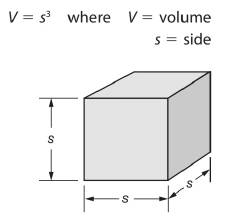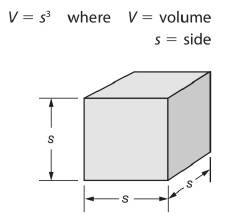
(a)
The length of side of the given cube.
Answer to Problem 17A
Side length of given cube is
Explanation of Solution
Given information:
A cube is given whose volume is
Calculation:
As we know that volume of a cube is given by
So, side of a cube will be given as


Here, volume of the given cube is
So, side of the cube will be as follows:
Hence, side of given cube is
(b)
To find the length of side of the given cube.
Answer to Problem 17A
Side length of given cube is
Explanation of Solution
Given information:
A cube is given whose volume is
Calculation:
As we know that volume of a cube is given by
So, side of a cube will be given as


Here, volume of the given cube is
So, side of the cube will be -
Hence, side of given cube is
(c)
The length of side of the given cube.
Answer to Problem 17A
Side length of given cube is
Explanation of Solution
Given information:
A cube is given whose volume is
Calculation:
As we know that volume of a cube is given by
So, side of a cube will be given as


Here, volume of the given cube is
So, side of the cube will be -
Hence, side of given cube is
(d)
] length of side of the given cube.
Answer to Problem 17A
Side length of given cube is
Explanation of Solution
Given information:
A cube is given whose volume is
Calculation:
As we know that volume of a cube is given by
So, side of a cube will be given as


Here, volume of the given cube is
So, side of the cube will be
Hence, side of given cube is
(e)
The length of side of the given cube.
Answer to Problem 17A
Side length of given cube is
Explanation of Solution
Given information:
A cube is given whose volume is
Calculation:
As we know that volume of a cube is given by -
So, side of a cube will be given as -


Here, volume of the given cube is
So, side of the cube will be -
Hence, side of given cube is
Want to see more full solutions like this?
Chapter 15 Solutions
Mathematics For Machine Technology
- Let U = {0, 1, 2, 3, 4, 5, 6, 7, 8, 9, 10} be the universal set. Let A = {0, 1, 2, 3, 9} and B = {2, 3, 4, 5, 6}. Select all elements in An B. 1 2 ✓ 3 + 5 10 7 > 00 ☐ 10arrow_forwardComplete the missing components of the know-show table to prove the statement be- low. Alternatively, you may construct your own table to prove the statement using the strategy that comes to your mind. Statement: For all integers n, if n is odd, then n³ + 4n+5 is even. Step Know P P1 n³ is odd P2 P3 5 is odd 0 Step Reason Hypothesis Product of even and odd is even 5 = 2(2)+1 Show Reasonarrow_forwardConsider the following false statement: For all integers a and b, if ab = 1 (mod 8), then a = 1 (mod 8) or b = 1 (mod 8). (a) Which of the following could be used as a counterexample. Select all that apply. a = -7 and b = −7 a = 1 and b = 23 ☐ a = 3 and b: = −5 ☐ a = 4 and b = 6 □ a = −1 and b = −9arrow_forward
- 1. Given X' = X 3 e2t (a) Verify that X₁(t) = (e) and X2(t) = (et) - are solutions to the given system. (b) Verify that X₁(t) and X2(t) form a fundamental set on the interval (-∞, ∞). (c) Write the general solution to the given system. (d) Find the solution that satisfies the initial condition X(0) = ( 2 ).arrow_forwardProve that a relation X defined on a set A that is reflexive, symmetric and antisymmetric is an equivalence relation and determine the equivalence classes.arrow_forwardLet X be the relation defined on the power set of the set integers P(Z) by AXB whenever A U B is a finite set of integers. Prove whether or not X is reflexive, symmetric, antisymmetirc or transitivearrow_forward
- Page < 1 of 2 - ZOOM + 1) Answer the following questions by circling TRUE or FALSE (No explanation or work required). −1 0 01 i) If A = 0 0 2 0, then its eigenvalues are ₁ = 1,λ₂ = 2, and 13 0 0 = : 0. (TRUE FALSE) ii) A linear transformation is operation preserving because the same result occurs whether you perform the operations of addition and scalar multiplication before or after applying the linear transformation. ( TRUE FALSE) iii) A linear transformation that is one-to-one and onto is called an isomorphism. (TRUE FALSE) iv) If the standard matrix A for the linear transformation T: R³ → R³ is -1 0 01 A = 2 00, then T is invertible. (TRUE FALSE) 0 1 1. v) Let A, B, and C be square matrices of order n. If A is similar to B and B is similar to C, then A is similar to C. ( TRUE FALSE) 2) a) i) Find the matrix that produces the counterclockwise rotation of 30° about the z-axis. ii) Find the image of the vector (1,1,1) for the rotation described in i). b) Give a geometric description…arrow_forwardPls help ASAParrow_forward1. Except for the door and floor, a shed is built entirely out of plywood. How many square meters of plywood are needed to build the shed? (1 foot 0.3048 m) 10 ft. 7 ft. 3 ft. 18 ft. 17 ft. 15 ft.arrow_forward
- 1. Leigh plans to invest $2500 for 4 years. She is considering two options: • A compound interest Guaranteed Investment Certificate (GIC) earning 5.6% per year for 4 years • A simple interest government bond earning 6.1% per year for 4 years a) Determine the total interest earned for each option at the end of each year. GIC Year Principal Interest earned (5.6%) Total interest 1 2 3 4 Government Bond [2 Marks] Interest earned (6.1%) Year Principal 1 2 3 4 b) Which is the better option? Explain. Total interest c) If Leigh can only invest for 3 years, which is the better option? Explain.arrow_forwardPls help ASAParrow_forwardPls help ASAParrow_forward
 Mathematics For Machine TechnologyAdvanced MathISBN:9781337798310Author:Peterson, John.Publisher:Cengage Learning,
Mathematics For Machine TechnologyAdvanced MathISBN:9781337798310Author:Peterson, John.Publisher:Cengage Learning, Elementary Geometry For College Students, 7eGeometryISBN:9781337614085Author:Alexander, Daniel C.; Koeberlein, Geralyn M.Publisher:Cengage,
Elementary Geometry For College Students, 7eGeometryISBN:9781337614085Author:Alexander, Daniel C.; Koeberlein, Geralyn M.Publisher:Cengage, Holt Mcdougal Larson Pre-algebra: Student Edition...AlgebraISBN:9780547587776Author:HOLT MCDOUGALPublisher:HOLT MCDOUGAL
Holt Mcdougal Larson Pre-algebra: Student Edition...AlgebraISBN:9780547587776Author:HOLT MCDOUGALPublisher:HOLT MCDOUGAL Algebra: Structure And Method, Book 1AlgebraISBN:9780395977224Author:Richard G. Brown, Mary P. Dolciani, Robert H. Sorgenfrey, William L. ColePublisher:McDougal Littell
Algebra: Structure And Method, Book 1AlgebraISBN:9780395977224Author:Richard G. Brown, Mary P. Dolciani, Robert H. Sorgenfrey, William L. ColePublisher:McDougal Littell Glencoe Algebra 1, Student Edition, 9780079039897...AlgebraISBN:9780079039897Author:CarterPublisher:McGraw Hill
Glencoe Algebra 1, Student Edition, 9780079039897...AlgebraISBN:9780079039897Author:CarterPublisher:McGraw Hill Trigonometry (MindTap Course List)TrigonometryISBN:9781337278461Author:Ron LarsonPublisher:Cengage Learning
Trigonometry (MindTap Course List)TrigonometryISBN:9781337278461Author:Ron LarsonPublisher:Cengage Learning





